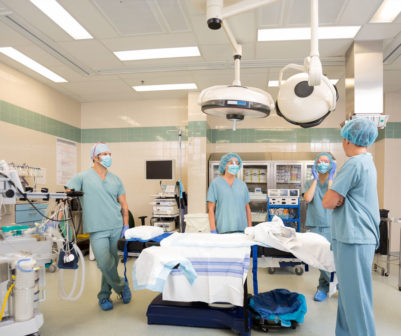Impact of lighting on patient outcomes
Lighting is a crucial element in the provision of best levels of care for patients in hospitals and its importance is underpinned by a growing body of research into its effects.
Quality of light has a deep impact on patient outcomes, the healing process and the improvements in health. Both the patients and hospital staff are affected in many ways by the way lighting is deployed in a medical setting.
In an emergency department or operating room, every second counts, and even the little details can be the difference between life and death. Doctors, nurses and other healthcare professionals need more than just training and skill—they need optimal conditions to provide the best possible care.


To ensure the best outcomes for patients, hospital lighting needs to provide the optimum conditions for the staff to operate most effectively. The innumerable visual tasks carried out minute by minute in a busy hospital depend on the amount of light, its quality and the colour spectrum made available, and studies show that the best light levels help to maximise performance.
The lighting in medical facilities also needs to take into account the fact that older staff will need more light in any situation, given that ageing reduces the ability of the eye lenses to transmit that light optimally.
Staff and patients may also experience visual discomfort from lighting glare, hum, and flicker, all of which can cause health problems. Negative effects such as eye strain, headaches, and eye irritation can lead to fatigue and attention deficit.
Lighting design in any hospital has to address specific needs and take account of specialist equipment, like MRI and CT imaging scanners for example. It also needs to be adapted to suit the varying conditions of patients.
Ineffective lighting is not only troublesome for staff and patients, it can be critical and the consequences deadly. Operating rooms are just one area where correct lighting design is fundamental to optimal outcomes for patients. For example, the wide range of surgical and monitoring equipment may not be compatible with standard lighting, with issues around frequency interference that will require adaptation.
The frequency interference can also be a problem with alarm systems in areas like neonatal intensive care units, as some lighting components operating on a certain frequency range can trigger alarms.
Focusing on the patient, the best lighting has positive effects on the healing process, with more studies indicating the benefits of paying attention to the body’s circadian rhythms.
Light is picked up through the retina and transmitted to the hypothalamus, which controls the body’s circadian rhythm – the biological events repeated regularly and this synchronises the body’s internal clock in 24-hour patterns.
Good lighting in a medical setting is best achieved through a combination of artificial and natural sources. Bright, high-quality light helps alertness during the day with the natural movement to lowered intensity and colour occurring in the evening. This helps create best conditions for deep sleep, which is when people produce the chemicals needed body processes, like those that regulate heart rhythm as well as weight control and mood.
For hospital staff, it’s crucial to pay attention to lighting effects on the body clock because if internal rhythms are out of synch, staff can feel drowsy, tired, and distracted. For example, when light activates the pineal gland, melatonin is suppressed, and low melatonin levels relate to being alert. Inadequate light levels mean that this process does not occur, which triggers feelings of depression and sleepiness.


Studies also show that high-quality light can help with specific patient groups, like those suffering with Alzheimer’s disease. It has been found that constant light levels have a beneficial effect with exposure to bright morning light reducing agitation among elderly patients with dementia.
Other studies indicate that both artificial bright light and natural light helps to combat depression among patients with bipolar disorder or seasonal affective disorder.
For hospitals, and the healthcare sector in general, the move to LED lighting offers opportunities to improve patient outcomes as well as saving energy. The technology continues to develop and now provides a wide range of solutions, with LED lighting controls providing even greater flexibility. Many LED sources are smaller than fluorescent and halogen so they are well suited to medical applications, where space is always at a premium.
And because LEDs generating less heat than other lighting technologies, the conditions for patients can be improved by making it easier to control room temperature.